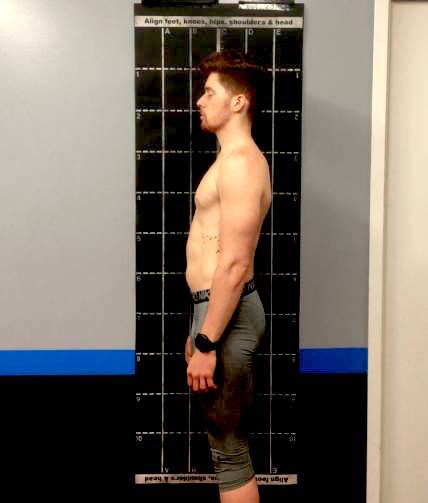Upper Cross Syndrome (UCS) is initially seen as a forward head posture with rounded shoulders, even while attempting to stand tall. Before you WebMD yourself crazy, let me shed some more light on this particular posture predicament.
Upper Cross Syndrome (UCS) is initially seen as a forward head posture with rounded shoulders, even while attempting to stand tall. Before you WebMD yourself crazy, let me shed some more light on this particular posture predicament.
This less than ideal head position stems from poor sitting posture, over/under-active muscles, previous injury, bad movement habits, and ultimately, results in a muscular imbalance between the front (anterior) and back (posterior) musculature of the upper body, becoming either short and tight or weak and long.
- Short and tight: Back of the neck (suboccipital), chest muscles (pectoralis minor), Rotator cuff (subscapularis), and front of the neck and chest (scalenes)
- Weak and long: Upper shoulders (trapezius/traps), mid-back between your shoulder blades (rhomboids), and upper spine rotators/stabilizers (deep cervical flexors and extensors)
Before moving on, the cervical muscles are most pertinent to correct, because they are most responsible for all of your potential head movement, both on intentionally and our of reaction. Which, by the way, your head weighs about 7 pounds so it would be in your best interest to make sure the muscles keeping it supported are up to the task!
What Does This Look Like?
The three most prominent postural symptoms of Upper Cross Syndrome are:
- Forward head posture
- Hunched back
- Forward rounded shoulders
Forward rounded shoulders (internally rotated) lead to a roundness of the upper back (kyphosis). Once the upper spine (cervical vertebrae) are exposed to prolonged tension in the wrong structural position, or out of ideal alignment, gravity packs a punch in pressing your head forward and down to follow where the rest of your spine is directed. Over time, this is what leads to a hunch back and a host of other shoulder/neck related injuries.
When your chest (pectoral) and neck (cervical) muscles become overworked and tight, it causes significant postural changes to occur because the muscles actually shorten in length; not permanently, but the longer it occurs, the more difficult it becomes to counteract. When the shoulders are rounded forward, the shoulder blades (scapulas) are pulled up and away from their ideal position.
Postural changes often cause a significant shift in the position and angle of the shoulder joint. If the joint is out of place, it cannot move properly. If the joint cannot move properly, you will lose out on potential strength, mobility, and in time it can lead to very serious injuries anywhere from your nose to your toes.
Your level of priority to assess, review, and reverse postural issues should be high. You won’t explode from UCS, but if unresolved, be ready for a host of chronic stress and overuse injuries. I won’t dive into those here because it is out of my professional scope of practice, but let that be enough of a kick in the butt to get checked by a professional.
Self Analysis: Do I Have UCS?
Find a perfectly vertical line. This can be a door frame, broomstick, piece of tape, basketball hoop pole; anything that you can stand next to and set up a camera (or have a helping hand). I personally use video, that way you can just pause and then screenshot the frames that matter (it is much easier than having to take one picture, go check how it came out, try again, etc).
Once the camera is set, take 3-5 full and deep cycles of breath to relax into a natural, resting standing posture. Don’t try and do anything fancy here, just simply stand like you would while in line at the DMV—we all have some great practice in that hell hole of a building. Luckily, I am spoiled and happen to have an align-mat handy (and decided to tape it to the wall). Your shot should appear like this:

Although my posture is not “perfect”, whatever that means, I would deem myself not having the symptoms of Upper Cross Syndrome. However, what I do see is a slight forward round in my shoulders, and a forward (anterior) tilted pelvis. Now that I can see it, I can take the necessary steps in correcting this imbalance. A picture can tell you a thousand words, but if you pay attention to the few words that matter, then you can begin to make big lifestyle changes.
Prevent UCS in Your Future
Let’s face it, your cell phone and sedentary activities are not going to disappear anytime soon. Luckily, there are many ways to strategically strengthen the muscles responsible for restoring ideal posture, as well as release tension from the others.
I recommend seeking a qualified physical/physiotherapist to properly diagnose UCS. Otherwise, a combination of specific strength, stretch, and myofascial release tools can definitely pave the way towards a more comfortable and optimal tomorrow.






